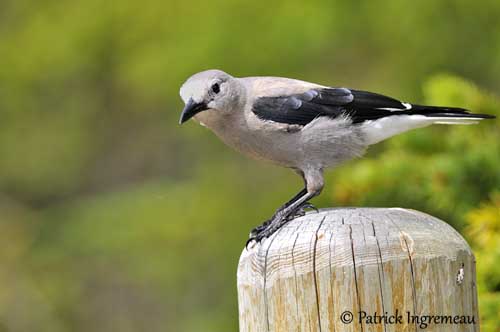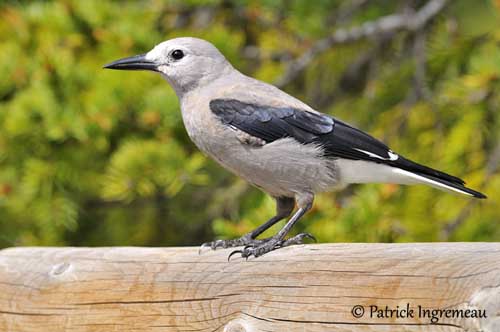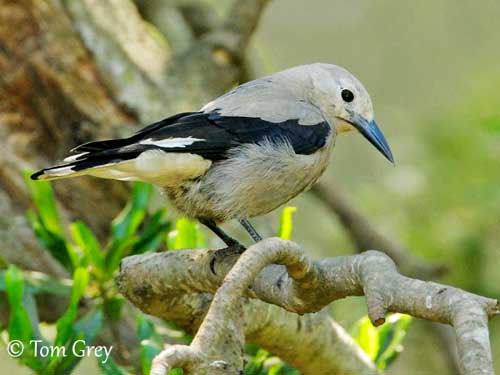
Fr: Cassenoix d’Amérique
All : Kiefernhäher
Esp : Cascanueces Americano
Ital: Nocciolaia di Clark
Nd: Grijze Notenkraker
Sd: Grå nötkråka
Photographers:
Tom Grey
Tom Grey's Bird Pictures
Patrick Ingremeau
TAMANDUA
René Lortie
http://rlortie.ca/
Text by Nicole Bouglouan
Sources:
HANDBOOK OF THE BIRDS OF THE WORLD Vol 14 by Josep del Hoyo-Andrew Elliot-David Christie - Lynx Edicions – ISBN: 9788496553507
FIELD GUIDE TO THE BIRDS OF NORTH AMERICA - National Geographic Society - ISBN: 0792274512
BirdLife International (BirdLife International
Bird Web (Seattle Audubon Society)
All About Birds (Cornell Lab of Ornithology)
Animal Diversity Web (University of Michigan Museum of Zoology)
What Bird-The ultimate Bird Guide (Mitchell Waite)
Clark’s Nutcracker
Nucifraga columbianus
Passeriforme Order – Corvidae Family
BIOMETRICS:
Length: 37-30 cm
Weight: 106-160 g
DESCRIPTION:
The Clark’s Nutcracker is a North American Corvidae species, very similar in behaviour to the Spotted Nutcracker from Eurasia. It hides numerous seeds and is able to find about 90% of them. These stored seeds allow the bird to survive long winters in mountainous areas.
The adult male has soft and loose plumage. Head, neck and body are ashy-grey, except on wings and tail. On the underparts, vent and undertail-coverts are white.
The flight feathers are black, with broad white tips to secondaries. The tail is white with contrasting black central pair of rectrices.
On the grey head, forehead and face may be whiter.
The long, sharply pointed bill is black. The eyes are brown. Legs and feet are black.
Both sexes are similar, with female slightly smaller than male.
The juvenile has mouse-grey body and face. Feathers are tipped buff. Wings and tail are duller and browner.

VOICE: SOUNDS BY XENO-CANTO
The Clark’s Nutcracker’s calls include a nasal, grating, drawn-out “kra-a-a”. Contact call is a sharp, rapid “kraak” also given in flight. The alarm call is a rapid series of 2-6 “kraaa” calls.
Greeting calls between mated birds are musical “chirrup”. We can also hear a slow frog-like rattle used during pair formation. Both mates also give clicks, pops, whistles and cackles.
This species is very vocal and up to 13 calls are included in its repertoire.
HABITAT:
The Clark’s Nutcracker is often seen in mountains, between 900 and 3900 metres of elevation. It frequents mountain coniferous forests with tree species producing large seeds, usually of genus Pinus.
It is found at highest elevations from early June to September-November, between 1800 and 3400 metres, in habitats with pine trees interspersed with shrubs, slopes, meadows and lakes.
It descends to lower areas in late autumn/winter in conifer forest where food sources are available.
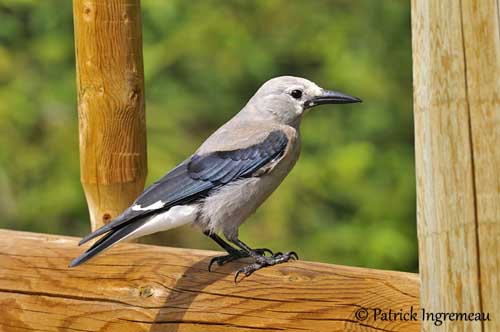
But its diet also includes a great variety of insects, small mammals, fruits and berries. It may sometimes feed at carcasses and it frequents bird feeders for peanuts and suet.
It takes its food both from ground and trees where it is very agile. It is able to extract the seeds from the pine cones, by using the long, pointed bill. It opens the scales and probes into the open cone. Some seeds are cracked in the bill, or placed intact in the sublingual pouch to carry them.
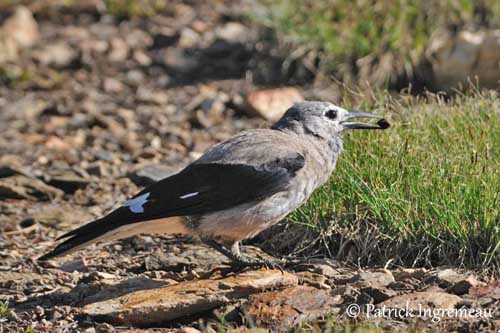
The Clark’s Nutcracker is resident but it performs numerous altitudinal movements throughout the year according to the food resources. Irruptions may occur due to local crop-failure.
FLIGHT:
The Clark’s Nutcracker performs deep, slow, crow-like wingbeats.
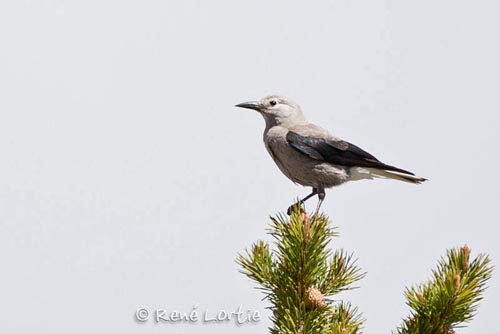
REPRODUCTION:
The breeding season starts in late winter, with nest-building in early March, the laying occurs between early March and mid-April, and the young fledge in April-May. They breed between 975 and 3660 metres of elevation.
The nest is a coarse structure, a platform made with sticks. The inner cup is lined with bark, moss and animal hair. It is placed in clump of conifer trees, near the caches where seeds are stored. The nest is built between 2 and 24 metres above the ground according to the tree.
The female lays 2-6 pale green or olive eggs with darker markings, but more often 2-3 eggs. Both sexes incubate during 18 days and brood the chicks at least during 10 days after hatching.
The chicks are fed by both parents and fledge about three weeks after hatching. They still depend on parents for 3-4 months after fledging, during which they learn to find caches, only by spotting the germinated seeds. The adults defend a small area around the nest.
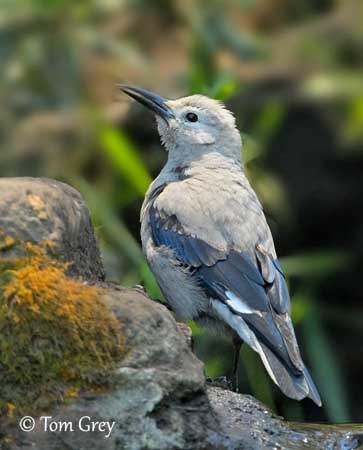
PROTECTION / THREATS / STATUS:
The Clark’s Nutcracker is locally common. According to food resources, irruptive movements and numbers may vary.
Populations appears stable to slightly increasing in spite of degradation of the habitats in some parts of the range, due to clearance of forest, drought and disease of pinyon pines.
However, this species is not currently threatened.
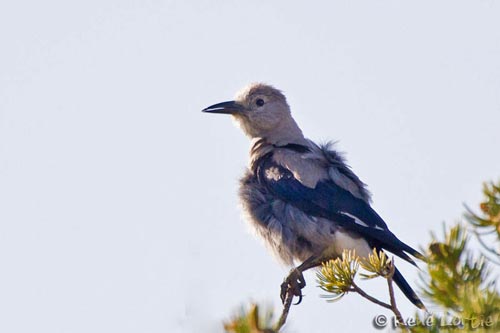
RANGE:
The Clark’s Nutcracker occurs in W North America from British Columbia and W Alberta, S to Baja California and W New Mexico. There is a small isolated population in Nuevo León, New Mexico.
BEHAVIOUR:
The Clark’s Nutcracker feeds primarily on pine seeds of Pinus trees. This bird has a sublingual pouch where 50/150 seeds can be hold. It carries these seeds and stores them usually in the ground for later consumption, in holes, at base of tree or rock, in bark, logs and stumps.
But these seeds may also germinate and produce new trees, helping the species to perpetuate its own habitat.
The Clark’s Nutcracker shows long-term spatial memory, and is able to relocate the caches, even several months later and under the snow!
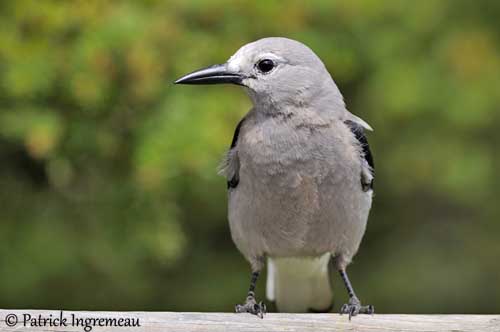
The Clark’s Nutcracker is usually seen in pairs or in small groups. Outside the breeding season, they gather in larger flocks of 15 to 80 birds.
The Clark’s Nutcracker is monogamous. They form long-term pair bonds and both mates remain together all year round on their territory and they defend it.
Several calls are related to breeding season. A more musical version of the usual call is given to proclaim the territory. Other sounds such as succession of cackles and whistles accompany the bowing displays. Courtship starts in December and the laying occurs in March. The stored seeds help them to survive during winter.
